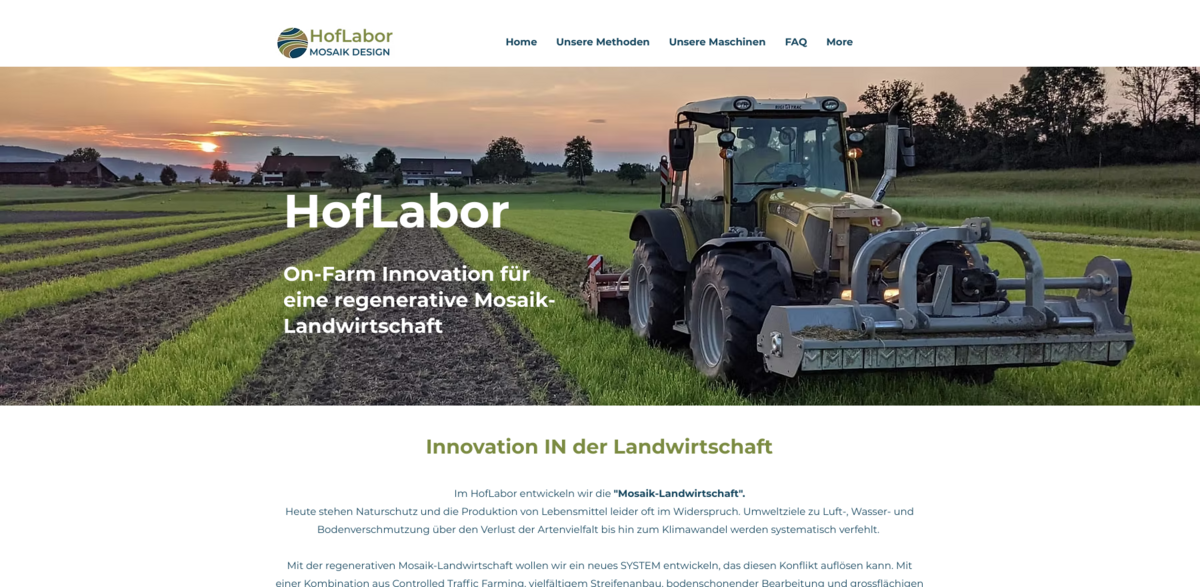What is the HofLabor Project?
HofLabor is all about on-farm innovation for something called Regenerative Mosaic Agriculture. In simple terms, it’s a fresh approach to farming that aims to solve a big problem: how to produce food while protecting nature. Often, food production and nature conservation seem to be at odds. Pollution, loss of biodiversity, and climate change are challenges that keep slipping through the cracks. HofLabor is developing a new SYSTEM that tackles this head-on. By mixing Controlled Traffic Farming, diverse strip cropping, soil-friendly cultivation, and large-scale mulching, they grow vegetables, grains, and potatoes on 20 hectares—without fertilizers or pesticides. It’s not just theory; it’s hands-on, practical farming with a twist.
The Main Benefit: A New Way to Farm
Here’s what makes HofLabor stand out:
- 20 hectares of farmland producing crops without any fertilizers or pesticides.
- Combining multiple methods like Controlled Traffic Farming (CTF) and strip cropping on 1.77 m wide strips.
- Using mulch as a natural layer to protect soil and plants from weather extremes.
- Maintaining a productive, “evergreen” soil system throughout the season with diverse root systems.
- Working closely with a network of farmers, researchers, and machinery developers to refine these methods.
Principles Behind Mosaic Agriculture
The heart of HofLabor’s approach lies in preserving soil infrastructure and boosting biodiversity. Controlled Traffic Farming is key—machines stick to fixed GPS tracks, which means less soil compaction and healthier ground. Deep loosening breaks up hard soil layers, and soil-conserving cultivation keeps the earth in shape. Diversity is another big deal: strip cropping creates habitats and food sources for beneficial organisms right next to the crops. No pesticides, no soluble fertilizers, and a tolerance for some weeds help keep the ecosystem balanced. Mulch acts like nature’s blanket, mimicking leaf fall to protect the soil from heat and heavy rain. And the goal? An “evergreen” system where soil stays productive all season long, thanks to seamless, diverse root systems.
Developing Methods and Machines
HofLabor isn’t just about ideas; it’s about action. They’re busy developing new agricultural methods and machines aimed at regenerating soils and managing weeds and pests without relying on chemicals. Efficiency is key, but so is sustainability. This means creating tools that help farmers work smarter and kinder with the land. It’s a learning curve, sure, but one that’s shared with a network of innovative farmers and machinery developers. Together, they’re pushing the boundaries of what’s possible in regenerative agriculture.
Digital Tools for Smarter Farming
Technology plays a big role in HofLabor’s vision. They’re testing and developing apps designed to help with everything from field planning and tracking to team coordination and knowledge sharing. These digital tools make it easier to manage complex farming systems and keep everyone on the same page. Plus, they support marketing efforts, helping to connect regenerative products with consumers who care. It’s about bringing modern tech into harmony with age-old farming wisdom.
Measuring Impact: Beyond the Environment
- Supports SDG 2: Zero Hunger by promoting sustainable food production.
- Contributes to SDG 12: Responsible Consumption and Production through reduced chemical use.
- Advances SDG 13: Climate Action by mitigating climate change impacts.
- Enhances SDG 15: Life on Land by preserving biodiversity and soil health.
- Supports SDG 17: Partnerships for the Goals via collaboration with farmers, researchers, and developers.
The Pioneer Network and Origins
HofLabor grew out of the pioneer farm SlowGrow, which was founded to make regenerative agriculture products accessible to everyone. SlowGrow itself is a successful operation, growing specialty crops with innovative mulch mixtures. HofLabor builds on this foundation, working with a network of forward-thinking farmers who believe in a biodiverse future for agriculture. Together, they develop and test new ideas, sharing knowledge and pushing the regenerative movement forward. It’s a community effort, driven by passion and a shared vision for healthier soils and better food.





















